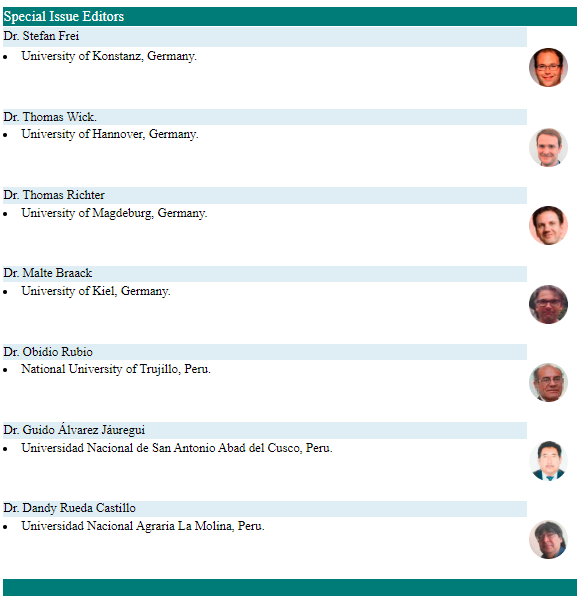A mathematical analysis of an eco-epidemiological model with prey-feedback effect and prey-refuge
DOI:
https://doi.org/10.17268/sel.mat.2025.01.06Keywords:
Eco-epidemiological model, Prey refuge, Feedback mechanisms, Stability analysis, Numerical simulationsAbstract
This study investigates an eco-epidemiological model incorporating feedback mechanisms and prey refuge, formulated as a system of nonlinear ordinary differential equations. The model describes interactions among susceptible prey, infected prey, and predators, including disease transmisión and nonlinear predation effects. We establish the existence, uniqueness, and positivity of solutions, and analyze their boundedness within a biologically feasible region. Local stability of equilibria is studied via linearization, while global stability is proven using Lyapunov functions. Numerical simulations complement the analytical results, demonstrating how key parameters affect the system’s long-term dynamics.
References
Allee WC, Park O, Emerson AE, Park T, Schmidt KP. Principles of animal ecology. W. B. Saundere. W. B. Saundere Co. Ltd.; 1949.
Das DK, Das K, Kar TK. Dynamical behaviour of infected predator–prey eco-epidemics with harvesting effort. Journal of Biological Systems. 2021;(7):1-27.
Lai X. Study of Virus Dynamics by Mathematical Models. The School of Graduate and Postdoctoral Studies, The University of Western Ontario; 2014.
Apreutesei N, Dimitriu G, Alla A, et al. On a prey–predator reaction–diffusion system with Holling type III functional response. Journal of Computational and Applied Mathematics. 2010;(235):366-79.
Almanza-Vasquez E, Ortiz R, Marin-Ramirez AM. Stability in predator-prey system Lotka–Volterra model incorporating a prey refuge like the law of mass action. Contemporary Engineering Sciences. 2018;(11):2049-57.
Bate A. Mathematical models in eco-epidemiology. Department of Mathematical Sciences, University of Bath; 2013.
Murray J. Mathematical Biology I: An Introduction. Springer, Texts in Applied Mathematics; 2013.
González-Olivares E, López-Cruz R, Rojas-Palma A. Prey refuge use: its impact on the dynamics of the Lotka-Volterra model. Selecciones Matemáticas. 2024;(9):287-301.
Naji RK, Mustafa AN. The Dynamics of an Eco-Epidemiological Model with Nonlinear Incidence Rate. Journal of Applied Mathematics. 2012;(852631).
Pino-Romero N, Salazar-Fernández CU. Modelo matemático de una cadena alimenticia depredador-presa: plancton-anchoveta. Revista de Matemática: Teoría y Aplicaciones. 2022;(29):69-103.
Chicone C. Ordinary Differential Equations with Applications. Springer, Texts in Applied Mathematics; 2006.
Lazaar O, Serhani M. Stability and optimal control of a prey–predator model with prey refuge and prey infection. International Journal of Dynamics and Control. 2023;(11):1934-51.
Jang SR, Hsiu-Chuan W. Deterministic predator–prey models with disease in the prey population. Journal of Biological Systems. 2020;(28):751-84.
Sun GQ, Zhang HT, Wang JS, et al. Mathematical modeling and mechanisms of pattern formation in ecological systems: a review. Nonlinear Dynamics. 2021;(104):1677-96.
López-Cruz R. Structured SI Epidemic Models with Applications to HIV Epidemic. School of Math and Statistical Sciences, Arizona State University; 2006.
Aguirre-Hernández B, Loredo-Villalobos C, Díaz-González E, Campos-Cantón E. Estabilidad de sistemas por medio de polinomios Hurwitz. Revista De Matemática: Teoría Y Aplicaciones. 2017;(24):61-77.
Slotine JJ, Li W. Applied nonlinear control. Prentice hall Englewood Cliffs, NJ; 1991.
Broyden CG. A class of methods for solving nonlinear simultaneous equations. Mathematics of Computation. 1965;(19):577-93.
Qiu S, Mu C, Yi H. Dynamics for a Three-Species Predator-Prey Model with Density-Dependent Motilities. Journal of Dynamics and Differential Equations. 2023;(35):709-33.
Kang AH. Analysis of an Eco-Epidemiological Model Considering Effect of Harvesting and Prey Refuge. Applied Mathematics. 2022;(10):733-44.
Chen HS, Stadtherr M. A modification of Powell’s dogleg method for solving systems of nonlinear equations. Computers & Chemical Engineering. 1981;(5):143-50.
Downloads
Published
How to Cite
Issue
Section
License

This work is licensed under a Creative Commons Attribution 4.0 International License.
The authors who publish in this journal accept the following conditions:
1. The authors retain the copyright and assign to the journal the right of the first publication, with the work registered with the Creative Commons Attribution License,Atribución 4.0 Internacional (CC BY 4.0) which allows third parties to use what is published whenever they mention the authorship of the work And to the first publication in this magazine.
2. Authors may make other independent and additional contractual arrangements for non-exclusive distribution of the version of the article published in this journal (eg, include it in an institutional repository or publish it in a book) provided they clearly state that The paper was first published in this journal.
3. Authors are encouraged to publish their work on the Internet (for example, on institutional or personal pages) before and during the review and publication process, as it can lead to productive exchanges and to a greater and more rapid dissemination Of the published work.












